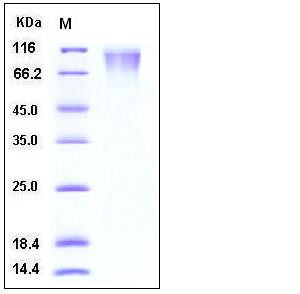Human CD208 / LAMP3 / DC-LAMP Protein (His Tag)
CD208,DC LAMP,DC-LAMP,DCLAMP,LAMP,LAMP-3,TSC403
- 100ug (NPP3682) Please inquiry
| Catalog Number | P10527-H08H |
|---|---|
| Organism Species | Human |
| Host | Human Cells |
| Synonyms | CD208,DC LAMP,DC-LAMP,DCLAMP,LAMP,LAMP-3,TSC403 |
| Molecular Weight | The secreted recombinant human LAMP3 consists of 365 amino acids with the predicted molecular mass of 39 kDa. As a result of glycosylation, rh LAMP3 migrates as an approximately 70-90 kDa band in SDS-PAGE under reducing conditions. |
| predicted N | Lys 28 |
| SDS-PAGE |  |
| Purity | > 95 % as determined by SDS-PAGE |
| Protein Construction | A DNA sequence encoding the mature form of human LAMP3 (NP_055213.2) (Lys 28-Thr 381) with a carboxy-terminal polyhistidine tag was expressed. |
| Bio-activity | |
| Research Area | Immunology |Cluster of Differentiation (CD) |Dendritic Cell CD Antigen |Other Dendritic Cell CD Antigen |
| Formulation | Lyophilized from sterile PBS, pH 7.4 1. Normally 5 % - 8 % trehalose, mannitol and 0.01% Tween80 are added as protectants before lyophilization. Specific concentrations are included in the hardcopy of COA. |
| Background | Dendritic cell-lysosomal associated membrane protein (DC-LAMP)/CD208, also known as LAMP3, is a member of the lysosomal associated membrane protein (LAMP) family, which is specifically expressed by human dendritic cells (DCs) upon activation and therefore serves as marker of human DC maturation. Confocal and immunoelectron microscopy showed that mouse DC-LAMP protein co-localizes with lbm180, a specific marker for the limiting membrane of lamellar bodies that contain surfactant protein B. The present study demonstrates that DC-LAMP is constitutively expressed by mouse, sheep, and human type II pneumocytes. DC-LAMP is constitutively expressed in normal type II pneumocytes. DC-LAMP is detected first in activated human DC within MHC class II molecules-containing compartments just before the translocation of MHC class II-peptide complexes to the cell surface, suggesting a possible involvement in this process. Furthermore, overexpression of LAMP3 is actively involved in tumor invasion through increased migration into lymph-vascular spaces. |
| Reference |
